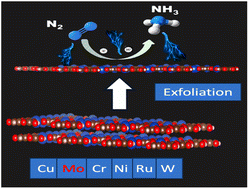J. Mater. Chem. A, 2024, 12,7058-7066
DOI: 10.1039/D3TA06666E, Paper
DOI: 10.1039/D3TA06666E, Paper
 Open Access
Open Access This article is licensed under a Creative Commons Attribution-NonCommercial 3.0 Unported Licence.
This article is licensed under a Creative Commons Attribution-NonCommercial 3.0 Unported Licence.Hassan A. Alhadidi Almheiri, Nirpendra Singh, Dinesh Shetty, Kyriaki Polychronopoulou, Ali A. Alhammadi
This work investigates a Mo–Tp 2D MOF screened from a number of different transition-metal-based 2D MOFs. After exfoliation, the Mo–Tp 2D MOF produces ammonia via the distal pathway at a very low limiting potential of −0.38 V.
The content of this RSS Feed (c) The Royal Society of Chemistry
This work investigates a Mo–Tp 2D MOF screened from a number of different transition-metal-based 2D MOFs. After exfoliation, the Mo–Tp 2D MOF produces ammonia via the distal pathway at a very low limiting potential of −0.38 V.
The content of this RSS Feed (c) The Royal Society of Chemistry

